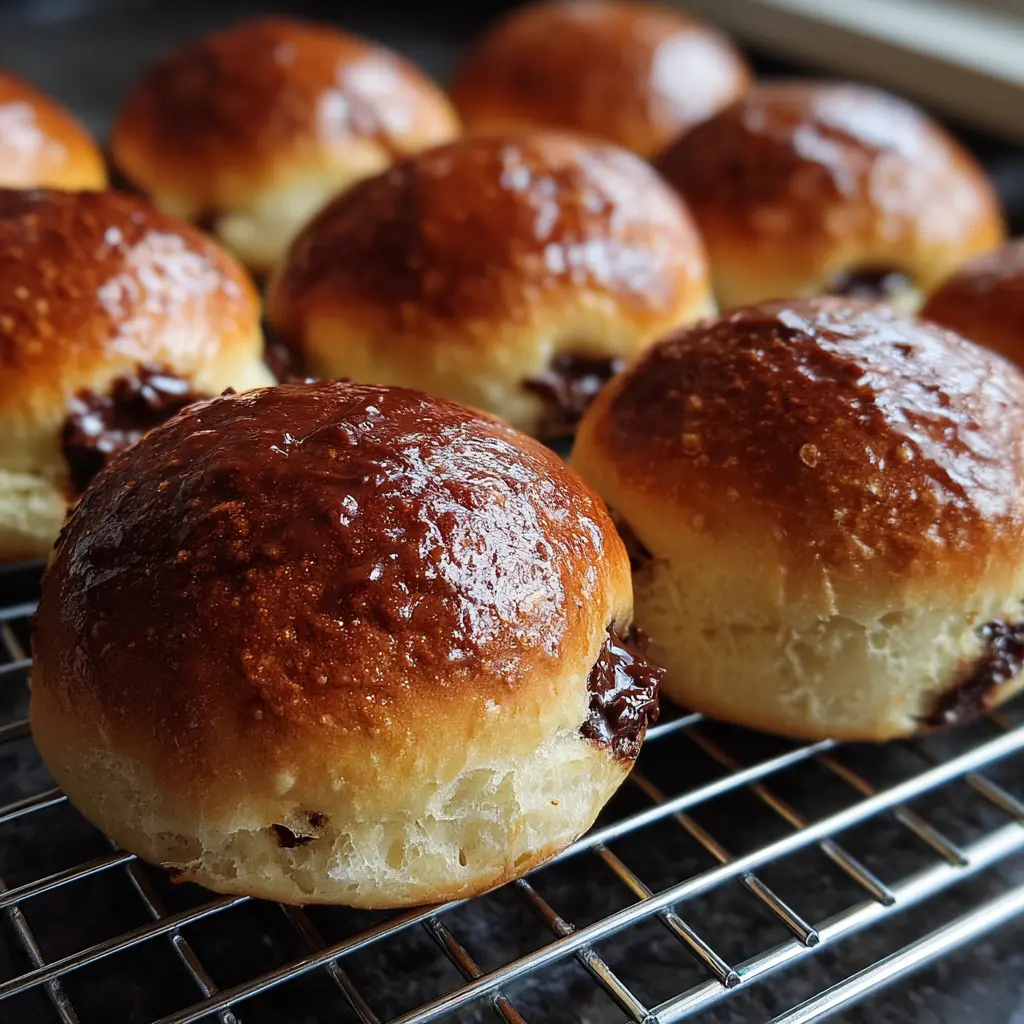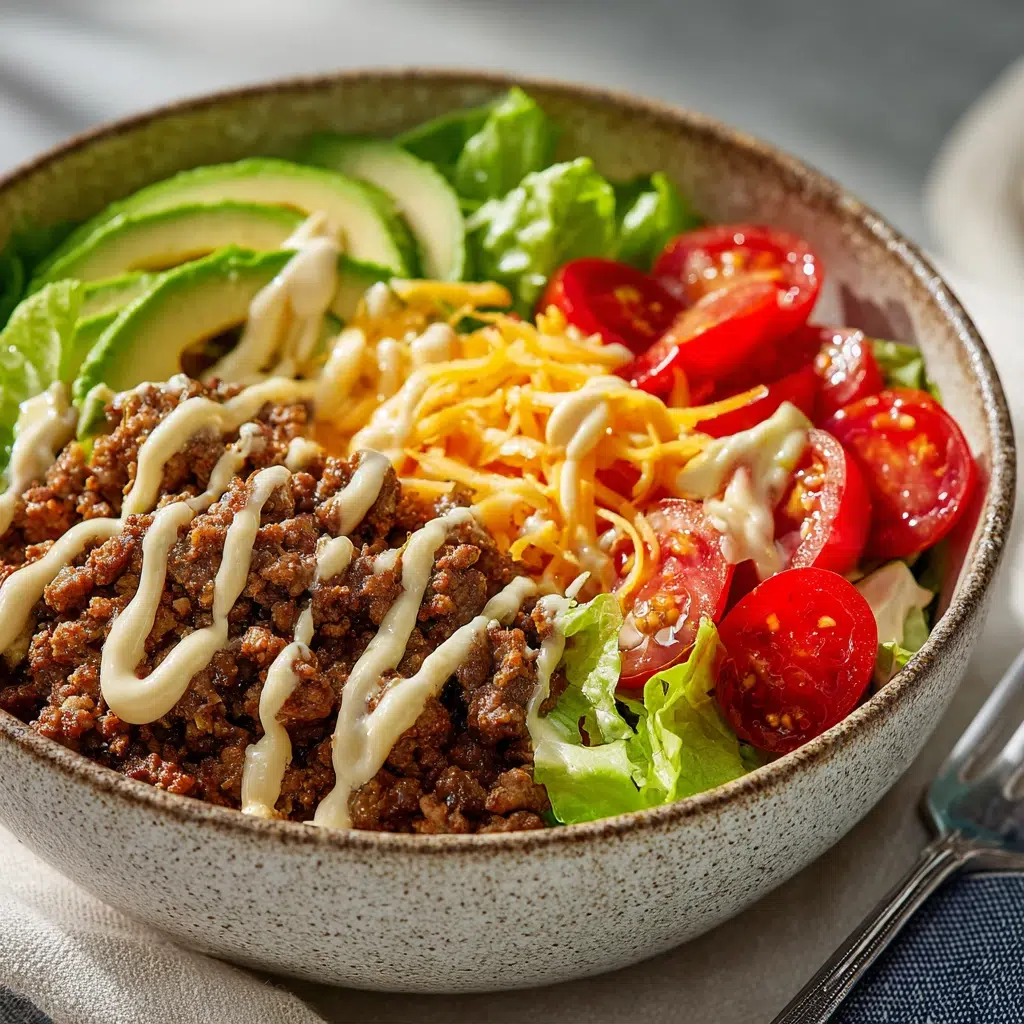When I was a child, my grandmother kept a row of glass jars tucked neatly in the back of her pantry. Each jar glowed with a golden hue, flecked with red and green peppers. It wasn’t until years later that I realized those jars held her homemade hot pepper mustard—a recipe she guarded as tightly as any family treasure. The first taste was unforgettable: a fiery bite from the peppers balanced by the tangy depth of mustard, followed by a touch of sweetness that lingered just long enough to make me reach for more.
That moment sparked my love for bold condiments, and today, hot pepper with mustard recipes remain one of the most versatile homemade spreads you can make. From burgers to glazed meats, this condiment transforms simple dishes into flavorful experiences. Unlike store-bought versions, homemade hot pepper mustard puts you in control—you decide the heat, the sweetness, and even the texture.
Homemade recipes also mean cleaner ingredients. No preservatives, no mystery additives—just peppers, mustard, vinegar, and a little creativity. Plus, if you enjoy preserving, this recipe is a canner’s dream. For reliable, safe canning tips based on trusted food preservation science, follow the University of Georgia’s guidelines for hot pepper relish canning, which share principles very similar to mustard-based condiments Home Food Preservation.
And if you’re hungry for more flavor inspiration, don’t miss this spicy and tangy cousin—chow chow relish—which shares the same bold, zesty family as hot pepper mustard.
So let’s step into the kitchen, stir up some memories, and discover how this condiment can become your new go-to recipe.
A Fiery Family Heirloom—Discovering Hot Pepper Mustard
A Spicy Memory from Grandma’s Kitchen
For many families, hot pepper mustard is more than just a recipe—it’s a tradition. Passed down from one generation to the next, this condiment often carries with it stories of harvests, gardens, and kitchen tables where peppers were chopped, mustard stirred, and jars carefully sealed. The recipe became a way to preserve not only fresh ingredients but also family heritage.
Grandma’s version might have leaned sweeter, with banana peppers mellowing out the bite, while others prefer the fiery edge of jalapeños or habaneros. Regardless of the pepper choice, one thing remained constant: hot pepper mustard always had the power to wake up a sandwich, brighten a plate of meats, and bring people back for seconds.
Why Hot Pepper with Mustard Recipes Are More Than Condiments
On the surface, hot pepper mustard might look like just another spread. But its magic lies in versatility. It’s a condiment that straddles multiple culinary worlds:
- As a spread: On sandwiches, burgers, or wraps, it adds tang and fire.
- As a glaze: Brushed onto chicken or ham, it caramelizes beautifully.
- As a dip: When mixed with cream cheese or yogurt, it transforms into a party favorite.
Hot pepper with mustard recipes are also about creativity. Some cooks lean into the sweet side, stirring in brown sugar or honey. Others chase the heat, stacking habaneros or serranos into the pot. And still others experiment with fruit infusions like peach or apricot to create unexpected but irresistible flavor combinations.
In short, hot pepper mustard isn’t just a condiment—it’s a canvas for your own flavor story.
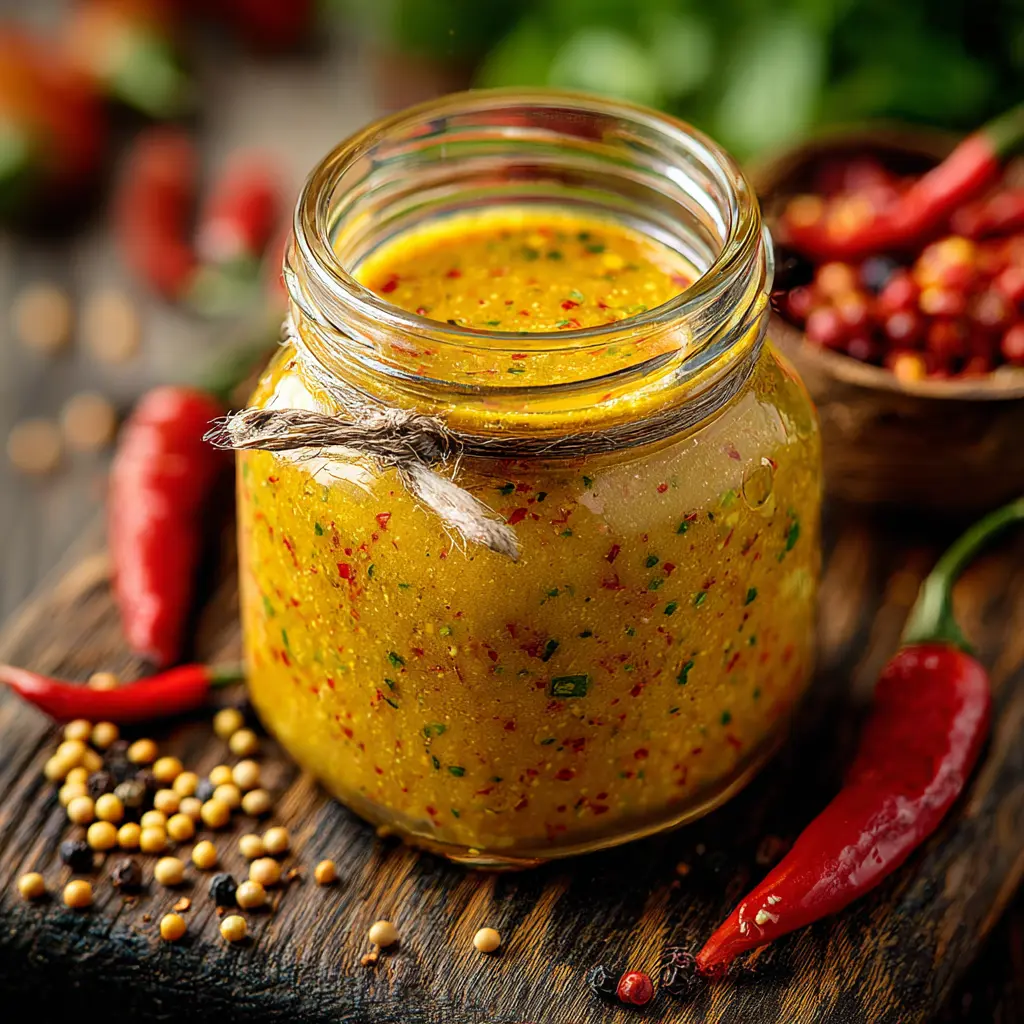
Hot Pepper Mustard
Ingredients
Equipment
Method
- Wash and chop the peppers. Remove stems and most seeds depending on your preferred heat level. Use gloves when handling hot peppers.
- In a food processor, pulse chopped peppers until finely minced (or leave slightly chunky for texture).
- In a large stainless-steel pot, combine yellow mustard, vinegar, and sugar. Stir over medium heat until sugar is dissolved.
- Add chopped peppers to the mustard base. Bring to a boil, then reduce heat and simmer for 10–15 minutes, stirring often.
- Whisk flour or cornstarch with cold water to make a slurry. Slowly add to the pot while stirring constantly to avoid lumps.
- Continue simmering until the mustard reaches a thick, spreadable consistency. Stir in turmeric or paprika if using.
- Let cool slightly and pour into jars. Store in the fridge for up to 4 weeks or follow safe canning guidelines for long-term storage.
Nutrition
Notes
Tried this recipe?
Let us know how it was!Essential Ingredients for Hot Pepper with Mustard Recipes
Choosing the Right Peppers—Banana, Jalapeño, Habanero
The peppers you choose will shape both the heat level and the overall personality of your hot pepper mustard. For a gentle kick, banana peppers and Hungarian wax peppers are excellent. They add flavor without overwhelming heat, making the recipe family-friendly. If you’re after more spice, jalapeños bring medium heat and a grassy flavor, while habaneros or serranos deliver a fiery punch that lingers.
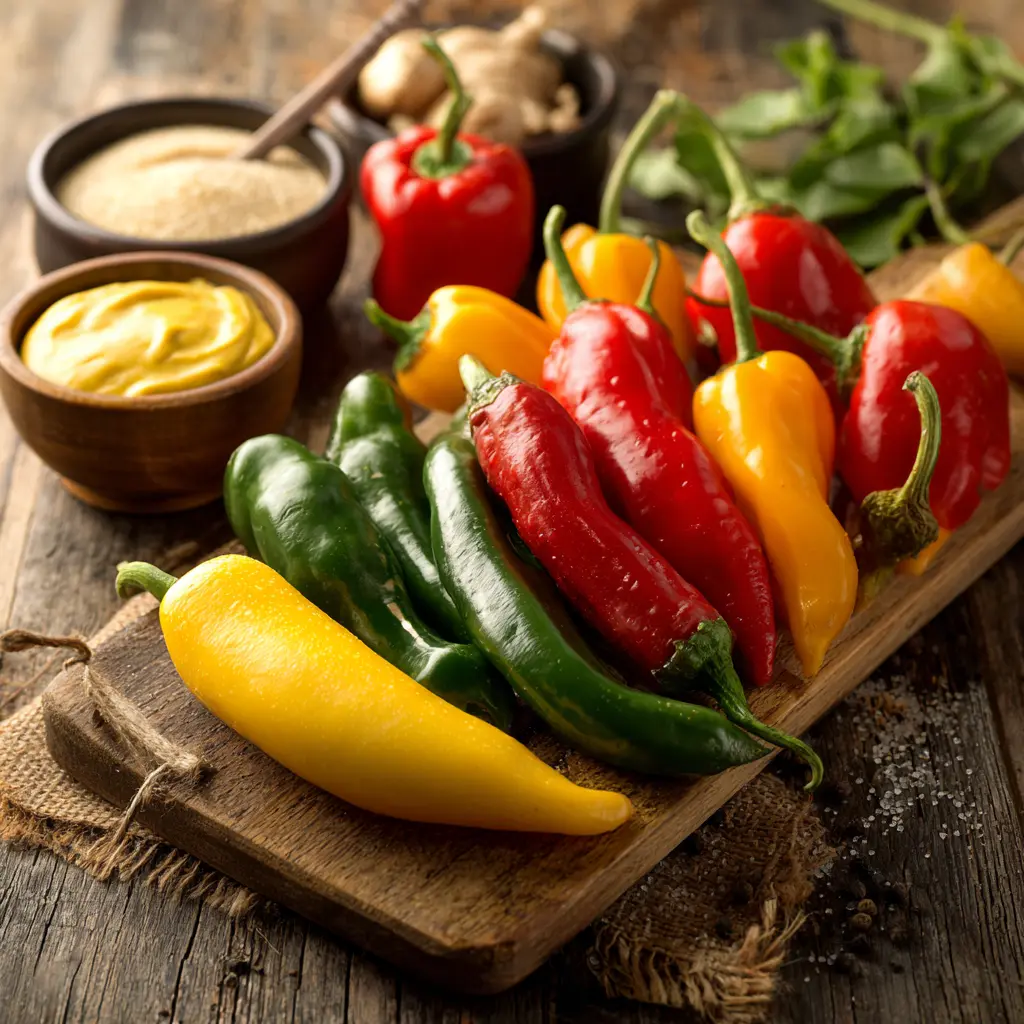
Here’s a quick reference table to help you decide:
| Pepper Type | Heat Level (Scoville Units) | Flavor Profile | Best Use in Mustard |
|---|---|---|---|
| Banana Pepper | 0 – 500 | Mild, slightly tangy | Sweet, family-friendly batches |
| Hungarian Wax | 1,000 – 15,000 | Mild to medium, earthy | Balanced heat with a rustic touch |
| Jalapeño | 2,500 – 8,000 | Fresh, grassy, moderate spice | Medium-heat mustards for everyday use |
| Serrano | 10,000 – 23,000 | Sharp, crisp, hotter than jalapeño | Spicier mustards with bright, fresh kick |
| Habanero | 100,000 – 350,000 | Fruity, floral, very hot | Bold, fiery mustards for spice lovers |
A clever trick many cooks use is blending different peppers together. Mixing banana peppers with jalapeños, for example, creates a condiment that balances mild and hot notes. No matter what you choose, always wear gloves when handling hotter varieties. Capsaicin, the compound responsible for the burn, can irritate skin and eyes long after cooking.
Mustard Base, Vinegar, Sugar, and Thickeners—Balancing Heat, Tang, and Texture
At its core, hot pepper with mustard recipes combine just a few pantry staples. The base is yellow mustard, which provides a tangy backbone and a vibrant golden color. Vinegar joins in to sharpen the flavor while acting as a natural preservative. Sugar, whether white or brown, mellows the heat and rounds out the tang, while also helping the mustard caramelize beautifully when used as a glaze.
To achieve the perfect spreadable consistency, you’ll need a thickener. Flour is traditional, but cornstarch is a great gluten-free alternative. Both ensure that your hot pepper mustard doesn’t end up runny or watery. Just remember: dissolve your thickener in a little water first to prevent clumping.
For a variation that plays up the richness, some cooks even use brown sugar for a deeper, molasses-like sweetness. If you enjoy exploring sweet-savory flavor pairings, don’t miss recipes like this cheesy ground chicken pasta, where balance between spice and creaminess creates unforgettable results.
Step-by-Step: How to Make Hot Pepper Mustard at Home
Prepping the Peppers—Washing, Deseeding, Chopping
Every great hot pepper mustard recipe starts with fresh, vibrant peppers. Begin by rinsing them thoroughly to remove any dirt or pesticide residue. Next, cut off the stems and remove most of the seeds, unless you want extra heat. Seeds and membranes contain much of the pepper’s fire, so adjusting how much you keep allows you to control the spice level.
Once cleaned, chop the peppers finely with a sharp knife or pulse them in a food processor for a smoother consistency. The finer the chop, the more evenly the peppers will blend into your mustard base, giving the final product a consistent flavor and texture.
Simmering the Mustard Mixture—Vinegar, Sugar, Heat Control
In a large stainless-steel pot, combine prepared yellow mustard, vinegar, and sugar. Stir the mixture gently over medium heat until the sugar fully dissolves. This forms the base where your chopped peppers will soon join.
Now add your peppers to the pot, stirring frequently as the mixture comes to a gentle boil. Keep the heat moderate—too high and the sugar can scorch, leaving behind a bitter aftertaste. Once it boils, reduce to a simmer and let it cook slowly. This step allows the peppers to soften, release their flavors, and marry into the mustard base.
If you want a vibrant golden color and earthy depth, consider adding spices like turmeric or paprika. These subtle additions enhance both flavor and appearance without overpowering the peppers.
Consistency is key here. Your mixture should be thick enough to coat the back of a spoon but not so stiff that it clumps. If you’re using a thickener like flour or cornstarch, whisk it into a small bowl of cold water first before adding it to the pot. This prevents lumps and ensures a smooth finish.
For another bold, home-style recipe that shows how simple ingredients can turn into something spectacular, check out this creole butter turkey breast recipe. Like hot pepper mustard, it’s all about layering flavors and balancing spice with richness.
No-Cook & Keto Versions of Hot Pepper Mustard
Quick-and-Easy Cold-Blend Method (No-Cook Hot Pepper Mustard Option)
Sometimes you want big flavor without the wait. That’s where the no-cook version of hot pepper mustard shines. Instead of simmering the mixture, you blend chopped peppers, yellow mustard, vinegar, sugar, and spices directly in a food processor or blender. The result is a fresher, brighter condiment that keeps the natural crunch and zing of the peppers intact.
This version is perfect for quick meals—think impromptu picnics, backyard barbecues, or last-minute sandwich spreads. Because it doesn’t go through the cooking process, the flavor leans sharper and less mellow than the simmered variety. Store it in the fridge in a sealed jar and enjoy within 7–10 days for the best taste.
Low-Carb and Keto-Friendly Variations (Hot Pepper Mustard Reimagined)
For anyone following a low-carb or keto lifestyle, traditional hot pepper with mustard recipes can easily be adapted. The key swap is replacing sugar with keto-approved sweeteners like erythritol, monk fruit, or stevia. These alternatives deliver the needed sweetness to balance the vinegar and mustard without spiking carbs.
Thickening can also be adjusted. Instead of flour, use xanthan gum, guar gum, or keep the recipe slightly thinner if you prefer a pourable sauce. These options work well in keeping the recipe both keto-friendly and gluten-free.
The flavor remains bold, tangy, and fiery—exactly what you want from hot pepper mustard. Whether you’re brushing it onto grilled chicken, whisking it into a vinaigrette, or spooning it over roasted vegetables, keto versions of this condiment ensure you don’t miss out on taste while staying within your dietary goals.
Canning Hot Pepper Mustard for Long-Term Use
What You Need—Jars, Lids, Funnels, and More
Canning hot pepper mustard is one of the best ways to keep its bold, tangy flavor available year-round. The process isn’t complicated, but having the right tools on hand makes everything smoother. Here’s your basic supply list:
- Mason jars (half-pint or pint size work best)
- Two-piece canning lids (flat lids and screw bands)
- Large stockpot or water bath canner
- Funnel for easy pouring
- Jar lifter and tongs for safe handling
- Clean towels and sterilized utensils
Always start with freshly washed jars and lids. Sterilizing them in boiling water for at least 10 minutes helps ensure food safety.
Safe Canning Steps—Sterilize, Process, Seal
Once your hot pepper mustard is simmered and ready, it’s time to move it into jars. Here’s a step-by-step breakdown:
- Sterilize the jars: Keep them hot until you’re ready to fill.
- Fill with mustard: Using a funnel, pour the hot mixture into jars, leaving about ¼ inch of headspace.
- Wipe rims: Clean the edges with a damp cloth to ensure a proper seal.
- Apply lids and bands: Screw them on until fingertip tight—not overly tight.
- Process in boiling water bath: Submerge jars in boiling water for 10–15 minutes, adjusting for altitude.
- Cool and check seals: Remove jars and let them rest. Listen for the satisfying “pop” that signals a secure vacuum seal.
When done correctly, canned hot pepper mustard can last up to a year stored in a cool, dark pantry. Always check seals before use—any jar with a loose lid, mold, or off smell should be discarded.
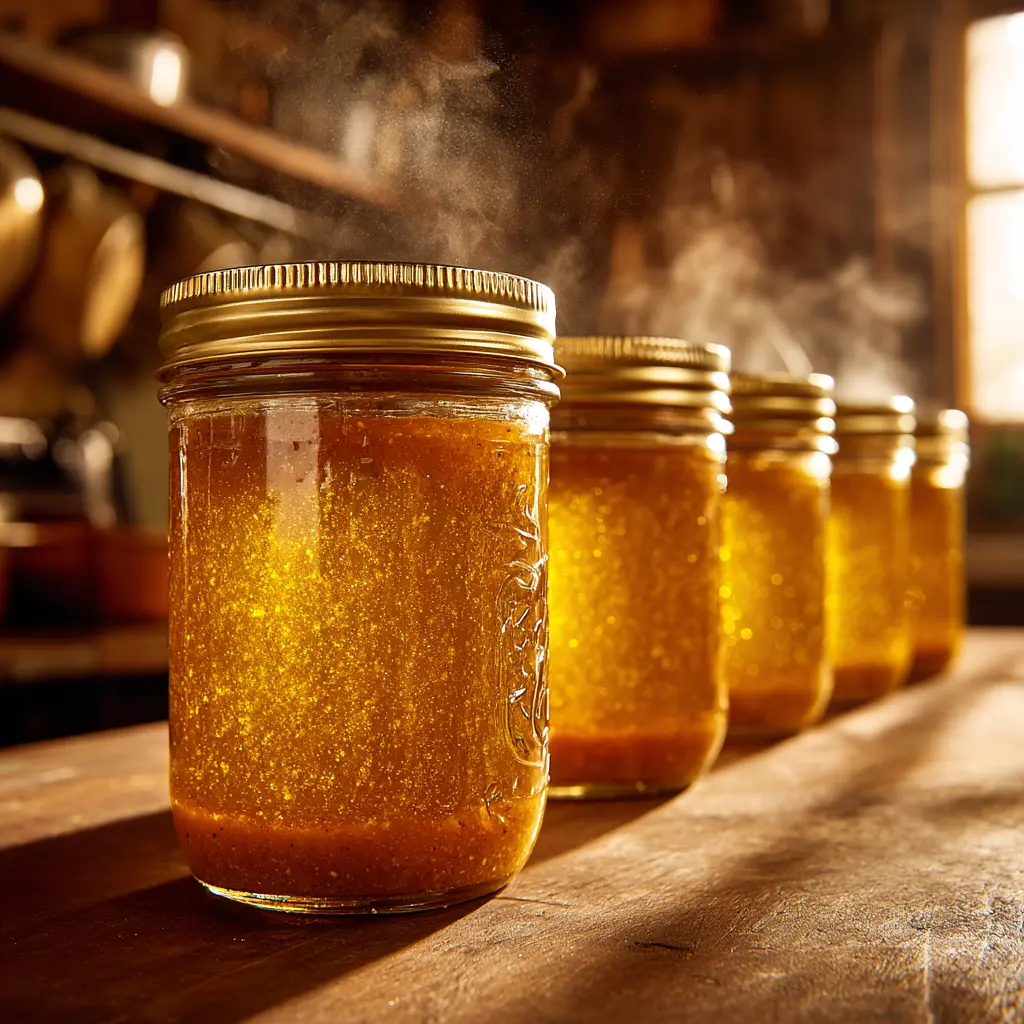
Storage and Flavor Benefits
Canning isn’t just about preservation—it’s about convenience. Having jars of hot pepper mustard on your shelf means you’re always ready for quick sandwiches, marinades, or glazes. In fact, flavors often deepen during storage, making canned batches even tastier over time.
Creative Ways to Use Hot Pepper Mustard
Slather on Sandwiches, Burgers, and Pretzels—Classic Combos
Hot pepper mustard shines in the simplest applications. Spread it on deli sandwiches, grilled burgers, or hot dogs, and you instantly elevate the flavor. Its mix of heat, tang, and sweetness cuts through fatty meats like sausage or brisket, while adding punch to vegetarian options like veggie burgers and roasted mushroom sandwiches.
For snacking, it doubles as the perfect dip for soft pretzels or crispy chicken tenders. The spreadable consistency makes it just right for game-day platters or picnic baskets.
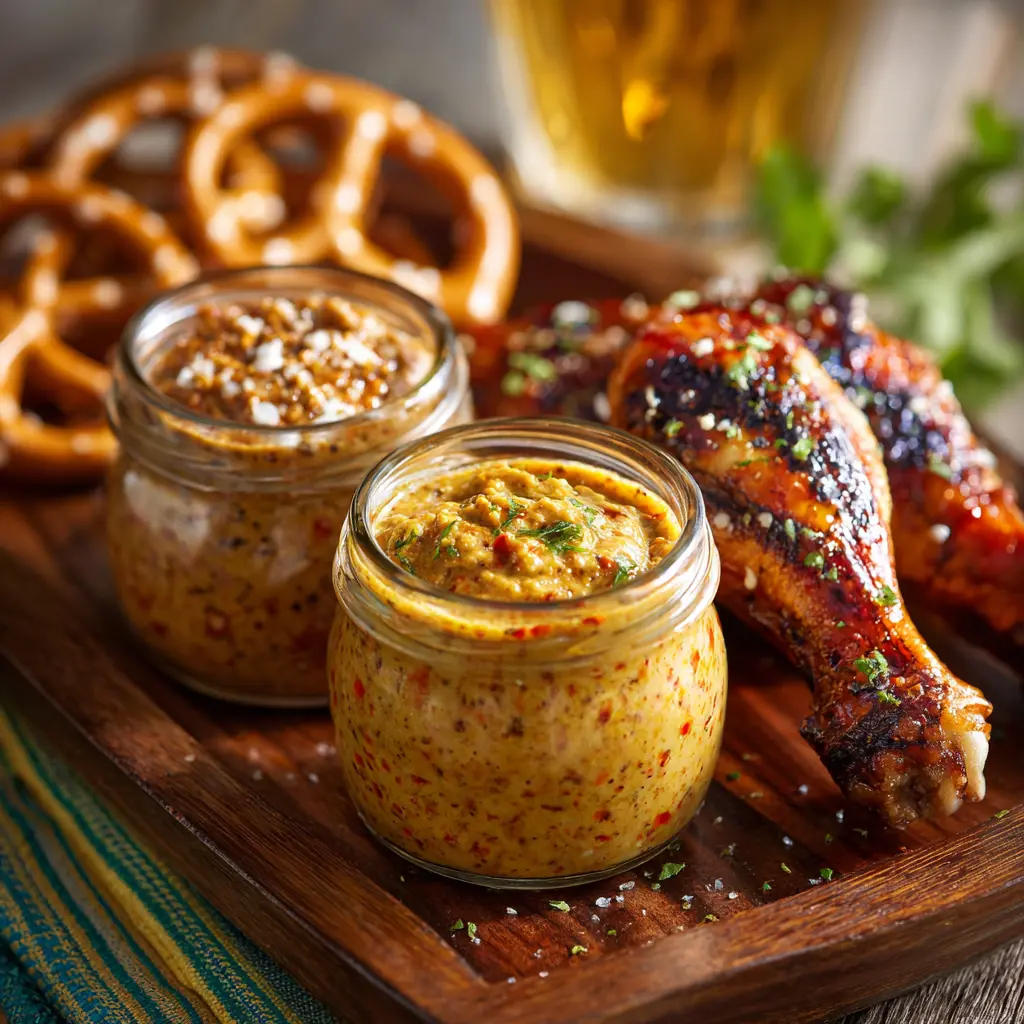
Dressings, Glazes, and Dips—Unexpected Culinary Twists
Think beyond the bun. Whisk a spoonful of hot pepper mustard into olive oil, honey, and vinegar to create a bold vinaigrette for salads or roasted vegetables. Its natural acidity balances creamy dressings beautifully, giving them a tangy edge.
As a glaze, it’s unbeatable. Brushed onto chicken wings, pork ribs, or even salmon, it caramelizes in the oven or on the grill, creating a sticky-sweet finish with a fiery kick. Stirring it into cream cheese or sour cream also makes an easy, crowd-pleasing dip that pairs with everything from crackers to raw veggies.
For a dish that shows how condiments can completely transform a recipe, take a look at this ultimate country-style beef ribs recipe. Just like hot pepper mustard, it’s all about layering bold flavors that make every bite unforgettable.
Flavor Variations to Explore
Jalapeño for Extra Kick, Banana Pepper and Brown Sugar for Sweetness
One of the joys of making hot pepper mustard at home is the freedom to experiment. For spice lovers, swapping in jalapeños adds a medium heat level that’s bold but approachable. Want something even more daring? A few habaneros will take your condiment into fiery territory.
On the sweeter side, banana peppers are perfect. They bring a mellow spice that pairs beautifully with brown sugar, giving your mustard a sweet-and-spicy balance that works wonders on pork chops, holiday hams, or even turkey sandwiches. This variation is especially popular in family gatherings where not everyone loves too much heat.
Fruit-Infused Blends—Peach or Apricot Spiced Mustard Twist
Fruit and mustard might sound unusual, but they’re a match made in flavor heaven. Adding peach or apricot preserves to your mustard base softens the heat of the peppers while introducing a subtle fruity sweetness. These blends shine when paired with cheese boards, grilled chicken, or roasted vegetables.
Peach-infused hot pepper mustard, for instance, is amazing spread over baked brie or used as a glaze for pork tenderloin. Apricot versions work wonderfully with chicken wings, offering that sweet-and-spicy combination people can’t stop reaching for.
Troubleshooting & Tips for Perfect Hot Pepper Mustard
Fixing Clumps—How to Avoid Lumps When Thickening
One of the most common frustrations when making hot pepper mustard is clumping. This usually happens when flour or cornstarch is added directly into the hot mixture. To prevent this, always whisk your thickener into a small amount of cold water before introducing it to the simmering mustard base. This creates a slurry that blends smoothly, avoiding unpleasant lumps.
Another helpful tip is to stir constantly while adding the slurry, keeping the heat at a gentle simmer. If clumps still form, you can run the mixture through a fine mesh sieve or give it a quick spin in a blender for a silky texture.
Managing Spice—Tone Down the Fire Mid-Batch
Sometimes the peppers you use pack more heat than expected, leaving your mustard a little too fiery. Luckily, there are ways to dial it back without wasting the batch. Adding extra sugar helps balance the spice, while an additional splash of mustard can mellow the intensity.
For an even creamier solution, stir in a spoonful of honey or plain yellow mustard after cooking. This doesn’t just soften the burn; it adds complexity to the flavor. And if you’d prefer a smoother spread with less bite, blending in a small amount of cream cheese or yogurt can transform your hot pepper mustard into a creamy dip.
Troubleshooting is part of the fun. With each adjustment, you’ll discover how flexible this condiment really is.
FAQ
What type of peppers work best for hot pepper mustard?
The best peppers depend on your heat preference. Banana peppers and Hungarian wax peppers deliver a mild kick, while jalapeños add medium spice. For those who love fiery condiments, habaneros or serranos bring intense heat. Many cooks mix varieties to balance flavor and spice.
How long does homemade hot pepper mustard last?
Refrigerated homemade hot pepper mustard typically lasts up to 4 weeks in an airtight container. If properly canned using safe water-bath methods, it can stay fresh for up to 12 months when stored in a cool, dark pantry. Always check seals before use.
Can I make hot pepper mustard gluten-free?
Yes, it’s easy to make hot pepper mustard gluten-free. Simply replace flour with cornstarch, arrowroot powder, or another gluten-free thickener. Also, double-check labels on mustard and vinegar to ensure no gluten-containing additives are included.
How do I reduce the heat if my mustard is too spicy?
If your mustard turns out hotter than expected, stir in more sugar, add extra yellow mustard, or blend in a spoonful of honey. For an even gentler approach, mix in cream cheese or Greek yogurt to create a creamy dip with balanced flavor.
Is hot pepper mustard safe to can at home?
Yes, hot pepper mustard is safe to can as long as you follow tested guidelines. Always sterilize jars, maintain proper headspace, and process in a boiling water bath. For trusted directions, consult the University of Georgia’s National Center for Home Food Preservation.
What are the best ways to use hot pepper with mustard recipes?
Hot pepper mustard is incredibly versatile. Spread it on burgers, sandwiches, and wraps, or use it as a dip for pretzels and chicken tenders. It also works beautifully as a glaze for pork, chicken, or salmon, and can be whisked into vinaigrettes or creamy dips.
Conclusion and Final Tips
Encouragement to Experiment with Recipes
Making your own hot pepper mustard is one of those kitchen projects that’s both simple and deeply rewarding. It allows you to play with flavors—choosing mild peppers for a softer bite or fiery varieties for bold heat. Adjusting sweetness, experimenting with spices, or even stirring in fruit preserves gives you endless ways to customize your batch. The beauty of this condiment lies in its flexibility: every small tweak can lead to an entirely new flavor experience.
Final Thoughts on the Versatility of Hot Pepper Mustard
At the end of the day, hot pepper with mustard recipes are far more than condiments. They’re flavor enhancers that work across your kitchen, whether you’re spreading them on sandwiches, dipping pretzels, or glazing meats. They brighten salads, complement cheese boards, and even add a kick to marinades.
Best of all, homemade hot pepper mustard means you control the ingredients—no preservatives, no fillers, just bold, natural flavor. It’s a condiment that feels as fresh and personal as the peppers you pick for it.
If you love condiments that transform everyday meals, you’ll also enjoy this marks sweet pizza sauce, another recipe that proves how much power a homemade sauce can bring to the table.
So why wait? Gather your peppers, grab some mustard, and create a condiment that will light up your kitchen. Once you try it, you may never go back to store-bought.



